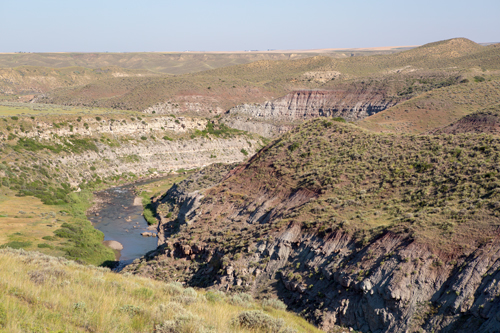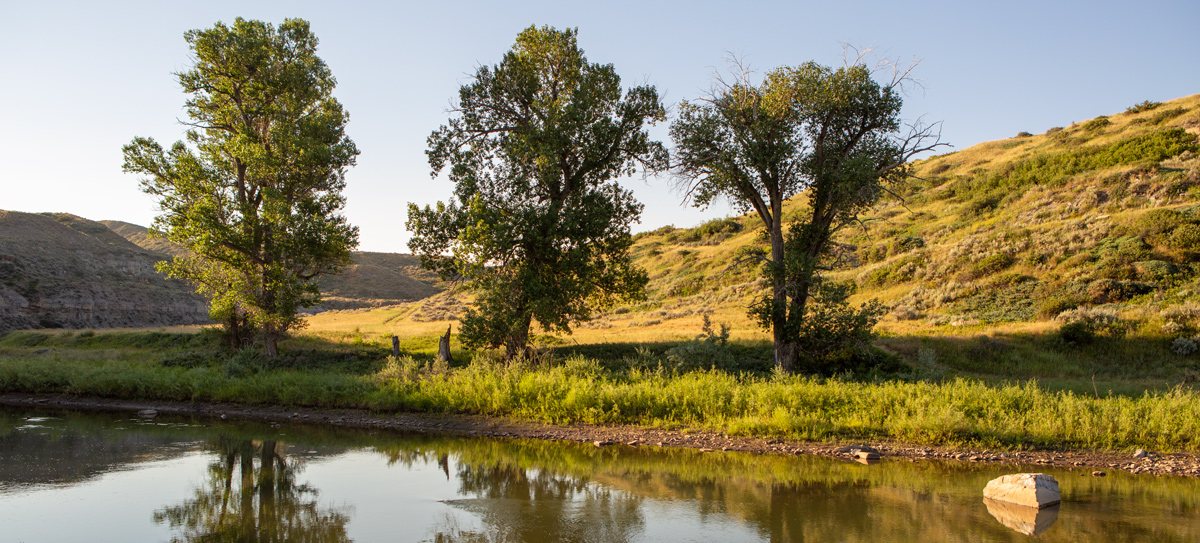Clark leaves Lower Portage Camp to map the Great Falls and survey a route for the upcoming portage. At camp, five dugout canoes are walked up Belt Creek and then taken out of the water to dry. Six men prepare wheels to cart the heavy boats, Lewis needs more hides for the iron-framed boat, and Sacagawea‘s health improves.
Sacagawea Much Better
by Yellowstone Public Radio[1]Originally aired weekdays by Yellowstone Public Radio during the Bicentennial observance of 2003-2006. Narrated by Hal Hansen. Scripts by Whit Hansen and Ed Jacobson. Produced by Leni Holliman. © … Continue reading
Belt Creek, Start of Portage Hill
© 30 June 2015 by Kristopher K. Townsend. Permission to use granted under the Creative Commons Attribution-Share Alike 4.0 International license.
The green, flat area in the above photo is only break in the cliffs along Belt Creek. From here, the heavy dugout canoes would be carted up the hill to the plains above.
Portage Route Survey
Capt. Clark set out early this morning with five me[n] to examine the country and survey the river and portage
—Meriwether Lewis
Up Portage Creek
I employed them in taking five of the small canoes up the creek which we now call portage creek about 1¾ miles; here I had them taken out and lyed in the sun to dry.
—Meriwether Lewis
Below Portage Hill
the bluffs of this creek below and those of the river above it’s entrance are so steep that it would be almost impracticable to have gotten them on the plain. we found much difficulty in geting the canoes up this creek to the distance we were compelled to take them, in consequence of the rappids and rocks which obstruct the channel of the creek. The bluffs of this creek below and those of the river above it’s entrance are so steep that it would be almost impracticable to have gotten them on the plain.
—Meriwether Lewis
Cottonwood Trees on Belt (Portage) Creek
© 30 June 2015 by Kristopher K. Townsend. Permission to use granted under the Creative Commons Attribution-Share Alike 4.0 International license.
Lone Cottonwood Tree
we were fortunate enough to find one cottonwood tree just below the entrance of portage creek that was large enough to make our carrage wheels about 22 Inches in diameter; fortunate I say because I do not beleive that we could find another of the same size perfectly sound within 20 miles of us.
—Meriwether Lewis
Making Wagons
I set six men at work to pepare four sets of truck wheels with couplings, toungs and bodies, that they might either be used without the bodies for transporting our canoes, or with them in transporting our baggage
—Meriwether Lewis
Elk Skins for the Iron-framed Boat
I found that the Elk skins I had prepared for my boat were insufficient to compleat her, some of them having become dammaged by the weather and being frequently wet; to make up this deficiency I sent out two hunters this morning to hunt Elk
—Meriwether Lewis
Sacagawea Improves
The Indian woman much better today, I have still continued the same course of medecine; she is free from pain clear of fever, her pulse regular, and eats as heartily as I am willing to permit her of broiled buffaloe well seasoned with pepper and salt and rich soope of the same meat; I think therefore that there is every rational hope of her recovery.
—Meriwether Lewis
Weather Diary
State of the thermometer at rise
Weather Wind at rise
State of the thermometer at 4 OC. P.M. Weather Wind at 4 OC. P. M. State of river 50 [above 0] cloudy S W 57 [above 0] cloudy S. W fallen ½ in. the thermometer placed in the shade of a tree at the foot of the rappids. Capt Clark sets out to survey the river & portage
—Meriwether Lewis[2]To assist the reader, the editor of this web page has omitted the date column, merged the “State of the river” columns, and spelled out some abbreviations.
Experience the Lewis and Clark Trail
The Lewis and Clark Trail Experience—our sister site at lewisandclark.travel—connects the world to people and places on the Lewis and Clark Trail.
Plan a trip related to June 17, 1805:

The Great Falls Portage is a High Potential Historic Site along the Lewis and Clark National Historic Trail managed by the U.S. National Park Service. It includes Sulphur Springs (open to the public), the Lower Portage camp site (on private land), and the Upper Portage Camp Overlook.
Notes
| ↑1 | Originally aired weekdays by Yellowstone Public Radio during the Bicentennial observance of 2003-2006. Narrated by Hal Hansen. Scripts by Whit Hansen and Ed Jacobson. Produced by Leni Holliman. © 2003 by Yellowstone Public Radio. |
|---|---|
| ↑2 | To assist the reader, the editor of this web page has omitted the date column, merged the “State of the river” columns, and spelled out some abbreviations. |




